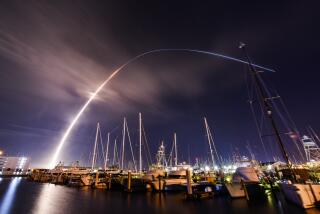SCIENCE / MEDICINE : With a Boost From JPL, Japanese Lunar Mission May Get Back on Track
Scientists at the Jet Propulsion Laboratory in Pasadena have come up with a way to salvage a troubled Japanese space mission, but they will need a little help from a strange area of space called the “fuzzy boundary.”
Japan became only the third nation in history to launch a successful lunar mission earlier this year when it sent a basketball-size probe into orbit around the moon.
The achievement was hailed as a major one for Japan’s Institute of Space and Astronautical Science. A small research center with an annual budget of only $150 million, it is the rival of Japan’s more powerful and better endowed National Space Development Agency.
But the success was diminished when the spacecraft’s transmitter failed just as the probe reached the moon and it could not send back the scientific data it was sent to collect.
Now experts at the Jet Propulsion Lab have devised a bold plan that could salvage Japan’s mission by diverting the mother ship that launched the lunar orbiter and sending it to the moon also. The maneuver would be a tricky one, because the larger spacecraft was not designed for lunar orbit. But Japanese officials have eagerly embraced JPL’s suggestion.
The joint Japanese-American effort began during an informal discussion, said Edward A. Belbruno, a mathematician at JPL who is among a handful of scientists dabbling in the fringe field of doing more with less--almost heresy in today’s world of space science.
Belbruno and James K. Miller, an expert in orbital mechanics at JPL, think they have figured out how to get the mother ship--now in an elliptical orbit around the Earth that carries it beyond the moon’s orbital path--to orbit no more than about 60 miles above the lunar surface.
If the mother ship had been designed to do that, the task would have been relatively simple. At just the right moment as it was passing the moon, the craft could have slowed down by firing its engines, allowing the moon’s gravity to pull it into close orbit.
But the spacecraft carries only a limited amount of fuel.
“I think they would spend too much propellant” if they tried to reach lunar orbit through traditional methods, Miller said. “They wouldn’t be able to do anything when they got there.”
So, how does a spaceship get into lunar orbit when it wasn’t designed to go there?
In a recent report to Japanese officials, the two JPL scientists said the larger spacecraft could be put into lunar orbit by taking advantage of the “fuzzy boundary.” That is a region of the sky about 1 million miles from Earth where the gravitational fields of the Earth and the sun nearly cancel each other out, leaving a spacecraft vulnerable to subtle influences.
“Funny things can happen there,” Belbruno said.
Miller compared the fuzzy boundary, also known as a weak stabilization boundary, to the top of the arch created when a baseball is tossed into the air. At the top, the baseball is moving very slowly, and even a minor force can change its course substantially.
The spacecraft could alter its course to carry it close to the moon by firing its thrusters while in the fuzzy boundary, where only a slight nudge would do the job. That would put it on the right course to intercept the moon, and the maneuver would use little fuel. Once it reaches the moon, the spacecraft could gently slip into orbit by once again firing its small thrusters inside another fuzzy boundary created by the canceling gravitational fields of the Earth, the sun and the moon.
If the plan works, the spacecraft could provide valuable scientific data. Miller said it carries a highly sensitive tracking device, a Doppler transponder, that would allow scientists to monitor its flight precisely. That, in turn, should tell much about the moon’s gravitational field, something that will be important in future moon missions.
Like the Earth, the moon is “very irregular, a lumpy body,” Miller said. So its gravitational field is somewhat irregular. Those irregularities could affect future satellites.
However, the real payoff from the Belbruno-Miller proposal--if it works--could come in the years ahead when huge quantities of construction materials are needed to build a permanent lunar base. By learning to take advantage of the fuzzy boundary, scientists could save enormous amounts of fuel that normally would be needed to transport the heavy equipment and supplies, Belbruno said.
The trip would take longer, about four months instead of three days, but “that translates into weight” that can be carried at no additional charge, he said.
Japanese officials are now examining the proposal. In their latest communications with the JPL team, Japanese engineers said they had done the same computations and had come up with the same conclusions. The attempt to try it could come next April.
GETTING TO THE MOON
Scientists at the Jet Propulsion Laboratory have come up with a plan to send a Japanese spaceship with a low supply of fuel into lunar orbit with help from an area in space called the ‘fuzzy boundary.’
The fuzzy boundary is a region of space where the gravitational fields of Earth and the sun nearly cancel each other.
1. Briefly firing the rocket’s thrusters while in the fuzzy boundary between Earth and the sun will put it on course for the moon using very little fuel.
2. A second firing in the Earth-moon fuzzy boundary will ease the spaceship into lunar orbit.






